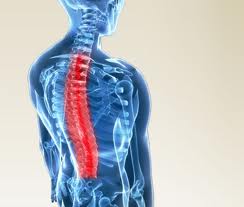 Mid Back Pain and Scheuermann’s Disease
Mid Back Pain and Scheuermann’s Disease
Lauren Bruce shares with us some of her experiences on Mid Back Pain.
Sore backs are one of the most common and disabling conditions we see as Physio’s. Unfortunately there is little discrimination with back pain – affecting all genders, ages, body types and fitness levels. Part of the reason back pain becomes so disabling to everyday life is the flow on effects in other areas of the body- headaches, pain with breathing (thereby making exercise/activity difficult) or a constant feeling of tight, ‘spasmy’ muscles or simply referral to hips and legs or arms.
Although there are a multitude of reasons or conditions that can explain why your back may be sore, there is one specific condition I’m writing about based on my own experience, and to share some tips/advice I wish I had been given years ago!
The mid back, or thoracic spine, begins at the base of the neck, and has attachments with the shoulder joint and the chest (via the ribs), ending at the lower back. Full movement within this section of the spine is important to maintain movement in these connecting sections – shoulders, chest expansion with breathing and upright posture. Subsequently, pain or dysfunction in this area can lead to secondary issues within those joints.
Scheuermann’s Disease
Scheuermann’s disease (aka Juvenile osteochondrosis) is a developmental condition, commonly diagnosed within teenagers and young adults within the thoracic spine. There are two distinct structural changes that can be seen with Scheuermann’s disease, and can be diagnosed through an XR. Firstly, vertebrae (spinal bones) develop somewhat abnormally, growing faster at the back than at the front leading to a ‘wedged’ shape. An additional abnormality is sometimes seen within the interface between the intervertebral disc and the vertebral bone, where nodes (Schmorl’s nodes) develop.
There is no known cause of Scheuermann’s disease, there does anecdotally appear to be a familial tendency. It is quite common and we as Physio’s see this condition fairly regularly.
What does all this mean?
It is important to recognise and diagnose it, as with any condition, there is a wide range of how severe the effects are seen. Mild cases will show some restricted movement within the thoracic spine and intermittent episodes of pain. They are sometimes a little more resilient to standard treatment, and the patients and therapists wonder why it is just not responding so fast to treatment that would otherwise be effective immediately.
The more severe cases present with an increased outward (hunchback) curvature of the thoracic spine (known as an increased kyphosis), and resultantly much larger restriction in movement and associated pain.
Physiotherapy and Scheuermann’s Disease
Our Primary aim is to re-assure the patient that Diagnosis of Scheurmann’s is not the end of the world for them. Treatment aims to reduce pain and stiffness, and teach strategies to maintain painfree range of movement and most importantly to educate the patient on why they have these symptoms and what they are able to do.
It remains important to implement stretches, exercises and lifestyle advice to self manage and help keep them feeling better.
- Core exercises – keep strength and stability within back to support day to day activities and exercise
- Specific stretches for the Thoracic Spine and surrounding joints (shoulder, chest, glutes, lower lumbar area)
- Heat in the form of heat packs, hot baths and spa or showers often get some more blood flowing and muscle relaxation
- These patients get a lot of benefit from regular swimming with good stroke and also from a specifically monitored and tailored Clinical Pilates program
- Postural advice‼ It is so important to maintain upright posture to protect back into the future and avoid mal-loading through the back with sport or daily activities/occupation. The more often posture is corrected, the more habitual it will become. We often refer to a term called stacking, with the aim to have our vertebrae sitting on top of each other as opposed to having a lean which pulls on so many more surrounding areas.
In more severe cases patients are sometimes referred to specialists and may have special back braces made to assist them or even require surgical correction, but in most cases once educated on the correct management, the patient carries on living a normal active lifestyle. There are many patients walking around who are not even aware they have Scheuermann’s Disease, and often get it diagnosed when having a back Xray for something completely different.
If you have been diagnosed with Scheuermann’s and are having troubles with ongoing back pain, come and see one of our highly trained MGS Physio’s who will help get you back on track.

thats cool